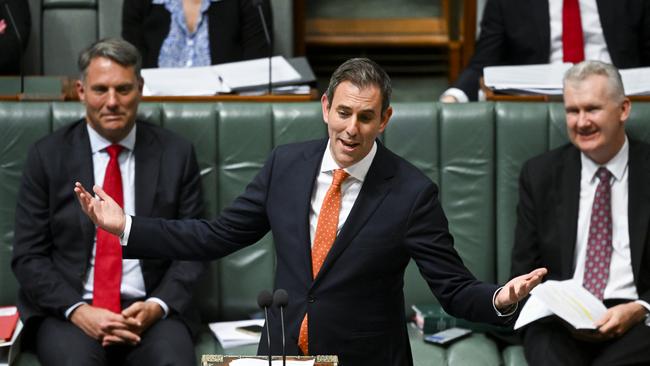And for Australia, the warnings from the data are very different from the rhetoric that surrounds the budget.
Australian developments will lag the US, so to understand what looks like happening on the local front we need to start in the US.
An early whiff of the severity of the looming US downturn came from conversations between Australian procurement officers and their Chinese counterparts, who reported significant falls in American ordering.
Now we are seeing US companies like Alphabet report lower results plus big falls in home building, and it’s clear that downward momentum is gathering pace.
The US began increasing its interest rates much earlier than Australia, so the initial reaction to the revelation of the downturn is for markets to anticipate that future US interest rate rises will be less than had previously been expected. Accordingly, US bonds rose in price (yields fall) and shares surge. Company by company, the profit repercussions of that downturn now starting to impact share US markets.
Our Treasury is blunt and expects the US growth in calendar 2023 to be virtually nil and edge up to 1.75 per cent in 2024. That’s a grim outlook given that in 2021 the US growth rate was 5.9 per cent.
As an aside, it will be very difficult for the Democrats to do well in both the looming midterm and the 2024 Presidential election. Accordingly, at this crucial time in world events, the US is likely to have a lame duck President.
Here in Australia our central bank was slow to wake up to what was happening, so our inflation is now out of control with consumer prices rising at their fastest pace since 1990.
Treasury forecasts that in the December quarter Australian inflation will hit 8.75 cent and this week’s 7.3 per cent rise in the September quarter shows the prediction is on track.

Treasury also sets out that while it will take a while for the ALP government spending machine to get into full gear, the new government has locked Australia into massive increases in budget deficits which skyrockets future debt and borrowing costs.
If Treasury is right, then the Reserve Bank must not only raise interest rates further to smash current inflation but, given the Canberra spending spree that is ahead, it might need to keep interest rates high until the government better understands the brutal rules of the market game.
While the Reserve Bank is basically alone in bringing on the downturn in the domestic economy, Treasury also expects that Australians will resume travelling abroad. This is great news for Qantas chief executive Alan Joyce, but it means money currently being spent in Australia will go overseas to add to the local impact of higher rates.
When the money markets saw our inflation figures and the horrific budget documents, the Australian dollar rose dramatically on the consequent higher interest rate outlook. Because of our home lending extravaganza during 2020-21, those higher interest rates will smash large parts of the economy as recent mortgagees suffer a brutal time.
Currently, the Australian share market is basically following the US but, as our looming downturn gathers pace, impacted companies are will see share price falls. As I pointed out earlier in the week, stagflation is a real risk.
Leading the downturn will be large parts of the housing market because higher interest rates savagely reduce the amount of money home borrowers can obtain from a bank.
The interest rate rises so far have slashed home borrowing availability by 20 per cent, which is why the Reserve Bank is now forecasting a 20 per cent fall in overall house prices. Theoretically, if interest rates rise by another 1.5 per cent, as the market expects, there will be a further 12 per cent contraction in home mortgage availability. Most of those who borrowed in the lending bonanza will have negative equity in their homes.
Accordingly, Treasury expects our growth rate to fall from the 2021 calendar year 4.9 per cent level to 1.5 per cent in 2024. The fall is not a steep as the US, partly because of our commodity outlook, but it will be severe in those areas of the economy being hit by higher interest rates.
Higher interest rates reduce the value of most property and shares, and so if the Treasury predictions are right, then many areas of the share and property markets face a tougher time.







Buried in the Australian budgetary documents is a remarkable Treasury picture of the future of Australia and the US. Share and bond markets are starting to come to very similar conclusions.